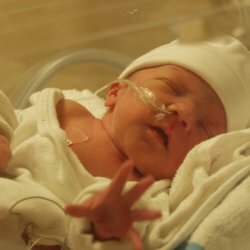Asphyxia in newborns
 One of the most common pathologies that occur in newborns is asphyxiation. Hearing this diagnosis, parents begin to worry. Of course, asphyxia is serious, but most often this pathology does not pose any threat to the health of the baby.
One of the most common pathologies that occur in newborns is asphyxiation. Hearing this diagnosis, parents begin to worry. Of course, asphyxia is serious, but most often this pathology does not pose any threat to the health of the baby.
Newborn asphyxiation occurs because the breathing process is disrupted and oxygen deficiency develops. Doctors distinguish two forms of asphyxia: primary and secondary. Primary asphyxia occurs at the time of the birth of the baby, and the secondary can develop in the first day of life crumbs.
Causes of asphyxia in newborns
Just because asphyxia does not arise. This requires certain factors. Most often, asphyxia occurs because of acute or chronic intrauterine hypoxia. In addition, some factors can provoke this pathology:
- intracranial birth injury in a newborn;
- immunological incompatibility of fetus and mother;
- is a developmental disorder that causes difficulty in breathing;
- obstruction of the respiratory tract by mucus, amniotic fluid and the like.
In addition, asphyxia in a newborn can lead extragenital diseases of a pregnant girl. These diseases include:
- late toxicosis-gestosis, which is accompanied by increased pressure and swelling of the extremities;
- diseases of the cardiovascular system, especially if they are in the stage of exacerbation;
- diabetes;
- pronounced iron deficiency anemia.
Various pathologies during pregnancy also very often lead to asphyxia in newborns. For example, pathology of the placenta, membranes, umbilical cord. Also, premature placental abruption, a prolonged anhydrous period or premature outpouring of amniotic fluid can cause the disease to develop in newborns.
Anatomical structural features in a future mother increase the risk of asphyxiation. For example, a pathologically narrow pelvis in the parturient can provoke an incorrect insertion of the fetal head and lead to abnormalities of labor.
Secondary asphyxia in a newborn can occur if the baby has any health problems: cerebral blood flow disorder, congenital pneumonia, disorders in the central nervous system, vomiting in the respiratory tract and the like.
What happens at the moment of asphyxiation?
During asphyxia in the newborn, metabolic processes and microcirculation of the blood are disturbed. Depending on how long the asphyxia lasts, the severity of the changes depends. With acute asphyxia, the total volume of blood in the body increases dramatically. In addition, the baby can develop hypovolemia. With hypovolemia, the consistency of the blood changes - its viscosity increases and it begins to thicken.
As a result of prolonged asphyxia, the baby can suffer internal vital organs: the liver, kidneys, heart, adrenal glands and brain, there may be a hemorrhage in these organs.
Symptoms of asphyxia in newborns
Asphyxia can be noticed by such pronounced signs: violation of breathing, changes in heart rhythm, violation of neuromuscular conduction, and so on. In the first minutes after birth, doctors carefully examine the crumb and assess its general condition. The condition of the baby is assessed on a special Apgar scale:
- The light form of asphyxiation is the least dangerous. It is 6-7 points on the Apgar scale. Babies, who are born with mild asphyxia, take their first breath during the first minute after birth. However, the breathing will be weakened. In addition, the baby will be reduced muscle tone.
- The average gravity on the Apgar scale is 4-5 points. Babies, who are born with an average degree of severity of hypoxia, make their first breath during the first minute, but their breathing is very weakened, besides it can be irregular. Scream of crumbs will be weak. He can have a bradycardia, tachycardia, a decrease in muscle tone and reflexes. Skin covers in the face, feet and hands will have a bluish tinge. The umbilical cord will pulsate strongly.
- The severe form of asphyxia is estimated at 1-3 points on a scale. With this form the baby's breathing will be irregular. Sometimes the baby does not breathe at all. There is no screaming, heartbeat is very slow, there are no reflexes, muscular atony or hypotension is observed. Skin covers are pale, and the umbilical cord does not pulsate. As a result of severe asphyxia, kidney failure often develops in the baby.
- If the overall score on the scale is 0, then the doctors diagnose a clinical death in the baby. To save the life of a crumb, resuscitation measures are immediately performed.
Treatment of acute asphyxia in toddlers
All babies born with asphyxia need immediate intensive care. The state of the baby depends on how effective the medical manipulations will be. First aid should be provided to the baby right in the delivery room.
During resuscitation, doctors monitor the basic indices of the baby's life: heart rate, frequency and depth of respiratory movements, as well as hematocrit.
Immediately after the baby's head appears, the doctor inserts a soft probe into the nose and mouth cavity, then with the help of a special electric suction the entire contents of the upper respiratory tract of the crumb( mucus, the remnants of the amniotic fluid) are removed. Then the umbilical cord is cut, and the baby is put on the resuscitation table under the rays of a special lamp. Doctors repeatedly clean the contents of the nasopharynx and stomach.
Once the respiratory and cardiac activities are restored and the condition is stabilized, the crumb is transferred to the intensive care unit. There doctors will do everything to prevent or eliminate the swelling of the brain, restore kidney function and normalize metabolic processes.
Rules for caring for a baby who suffered asphyxia
The baby who suffered asphyxiation should be at rest. Its head should be in a raised state. It is also very important to conduct intensive oxygen therapy. Babies, who were born with a mild form of asphyxia, are placed in a special oxygen chamber. Depending on the state of health, the baby is there from a few hours to several days. If the crumb has suffered an average or severe form of asphyxia, it is placed in a special kuvez.
All the time the baby should be observed. If necessary, doctors can re-suction the mucus from the upper respiratory tract. In addition, it is very important to monitor the indicators of bowel function, body temperature and diuresis.
If the crumb suffered an easy or moderate degree of asphyxiation, then the first feeding is allowed after 16 hours. If asphyxia was severe, then the first feeding is allowed only a day after the birth of the crumbs. Feeding in this case is done through a special probe. Breast doctors are allowed to feed such babies only when their condition is completely normalized.



